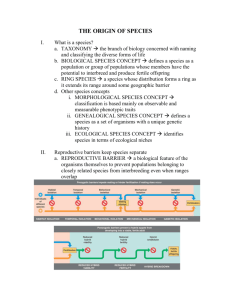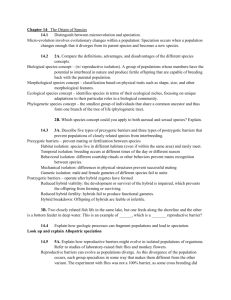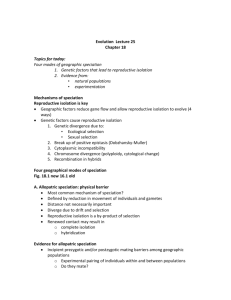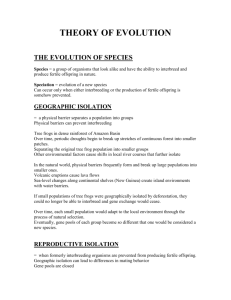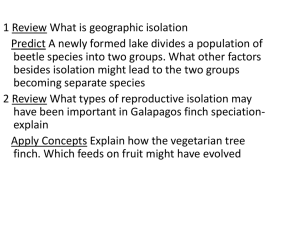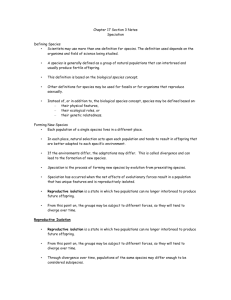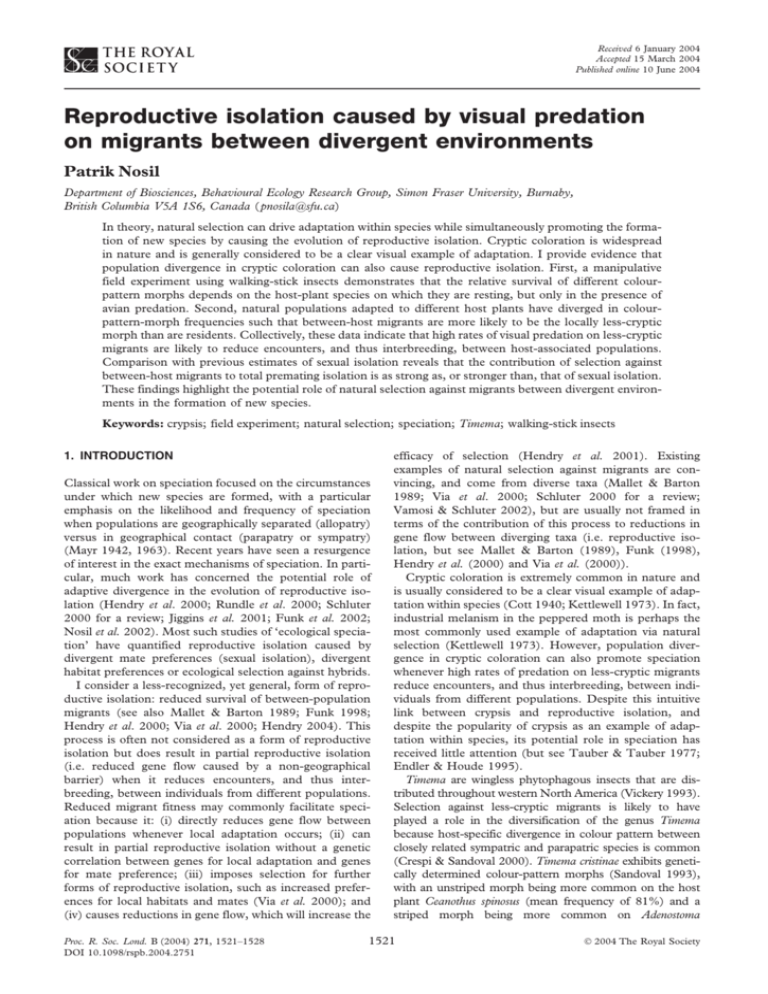
Received 6 January 2004
Accepted 15 March 2004
Published online 10 June 2004
Reproductive isolation caused by visual predation
on migrants between divergent environments
Patrik Nosil
Department of Biosciences, Behavioural Ecology Research Group, Simon Fraser University, Burnaby,
British Columbia V5A 1S6, Canada (pnosila@sfu.ca)
In theory, natural selection can drive adaptation within species while simultaneously promoting the formation of new species by causing the evolution of reproductive isolation. Cryptic coloration is widespread
in nature and is generally considered to be a clear visual example of adaptation. I provide evidence that
population divergence in cryptic coloration can also cause reproductive isolation. First, a manipulative
field experiment using walking-stick insects demonstrates that the relative survival of different colourpattern morphs depends on the host-plant species on which they are resting, but only in the presence of
avian predation. Second, natural populations adapted to different host plants have diverged in colourpattern-morph frequencies such that between-host migrants are more likely to be the locally less-cryptic
morph than are residents. Collectively, these data indicate that high rates of visual predation on less-cryptic
migrants are likely to reduce encounters, and thus interbreeding, between host-associated populations.
Comparison with previous estimates of sexual isolation reveals that the contribution of selection against
between-host migrants to total premating isolation is as strong as, or stronger than, that of sexual isolation.
These findings highlight the potential role of natural selection against migrants between divergent environments in the formation of new species.
Keywords: crypsis; field experiment; natural selection; speciation; Timema; walking-stick insects
1. INTRODUCTION
Classical work on speciation focused on the circumstances
under which new species are formed, with a particular
emphasis on the likelihood and frequency of speciation
when populations are geographically separated (allopatry)
versus in geographical contact (parapatry or sympatry)
(Mayr 1942, 1963). Recent years have seen a resurgence
of interest in the exact mechanisms of speciation. In particular, much work has concerned the potential role of
adaptive divergence in the evolution of reproductive isolation (Hendry et al. 2000; Rundle et al. 2000; Schluter
2000 for a review; Jiggins et al. 2001; Funk et al. 2002;
Nosil et al. 2002). Most such studies of ‘ecological speciation’ have quantified reproductive isolation caused by
divergent mate preferences (sexual isolation), divergent
habitat preferences or ecological selection against hybrids.
I consider a less-recognized, yet general, form of reproductive isolation: reduced survival of between-population
migrants (see also Mallet & Barton 1989; Funk 1998;
Hendry et al. 2000; Via et al. 2000; Hendry 2004). This
process is often not considered as a form of reproductive
isolation but does result in partial reproductive isolation
(i.e. reduced gene flow caused by a non-geographical
barrier) when it reduces encounters, and thus interbreeding, between individuals from different populations.
Reduced migrant fitness may commonly facilitate speciation because it: (i) directly reduces gene flow between
populations whenever local adaptation occurs; (ii) can
result in partial reproductive isolation without a genetic
correlation between genes for local adaptation and genes
for mate preference; (iii) imposes selection for further
forms of reproductive isolation, such as increased preferences for local habitats and mates (Via et al. 2000); and
(iv) causes reductions in gene flow, which will increase the
Proc. R. Soc. Lond. B (2004) 271, 1521–1528
DOI 10.1098/rspb.2004.2751
efficacy of selection (Hendry et al. 2001). Existing
examples of natural selection against migrants are convincing, and come from diverse taxa (Mallet & Barton
1989; Via et al. 2000; Schluter 2000 for a review;
Vamosi & Schluter 2002), but are usually not framed in
terms of the contribution of this process to reductions in
gene flow between diverging taxa (i.e. reproductive isolation, but see Mallet & Barton (1989), Funk (1998),
Hendry et al. (2000) and Via et al. (2000)).
Cryptic coloration is extremely common in nature and
is usually considered to be a clear visual example of adaptation within species (Cott 1940; Kettlewell 1973). In fact,
industrial melanism in the peppered moth is perhaps the
most commonly used example of adaptation via natural
selection (Kettlewell 1973). However, population divergence in cryptic coloration can also promote speciation
whenever high rates of predation on less-cryptic migrants
reduce encounters, and thus interbreeding, between individuals from different populations. Despite this intuitive
link between crypsis and reproductive isolation, and
despite the popularity of crypsis as an example of adaptation within species, its potential role in speciation has
received little attention (but see Tauber & Tauber 1977;
Endler & Houde 1995).
Timema are wingless phytophagous insects that are distributed throughout western North America (Vickery 1993).
Selection against less-cryptic migrants is likely to have
played a role in the diversification of the genus Timema
because host-specific divergence in colour pattern between
closely related sympatric and parapatric species is common
(Crespi & Sandoval 2000). Timema cristinae exhibits genetically determined colour-pattern morphs (Sandoval 1993),
with an unstriped morph being more common on the host
plant Ceanothus spinosus (mean frequency of 81%) and a
striped morph being more common on Adenostoma
1521
2004 The Royal Society
1522 P. Nosil Reduced survival of between-population migrants
fasciculatum (mean frequency of 72%) (Sandoval 1994a;
Nosil et al. 2002). Controlled predation trials using wild
scrub-jays and captive lizards have demonstrated that each
of these morphs is most cryptic on the plant on which it is
more common (Sandoval 1994b). Dominance of the
unstriped morph is incomplete (Sandoval 1993), and thus
a third, intermediate, morph (bearing a faint stripe) is also
found at low (less than 5%) frequency in some populations.
Local morph frequencies are temporally stable and geographical variation indicates that they are determined by a
gene flow–selection balance between host-plant patches
exhibiting the different selective regimes (Sandoval 1994a).
However, previous work on selection for crypsis in
T. cristinae has not estimated the relative survival of each
morph on each host plant in nature, and fitness in the
absence of predation is unknown, precluding estimates of
the magnitude of reproductive isolation caused by visual
predation on between-host migrants.
Two criteria are required for crypsis to contribute to
reproductive isolation between populations of T. cristinae
adapted to the use of different host-plant species. First,
the survivals of different colour-pattern morphs in natural
populations must depend on the host-plant species on
which they are resting, but only in the presence of visual
predation. Second, for immigrants to exhibit reduced fitness relative to residents, populations using different hosts
must have diverged in colour-pattern-morph frequencies
such that immigrants are more likely to be the locally nonmatching morph than are residents. First, I use a manipulative field experiment and data on morph frequencies in
natural populations of walking-stick insects to test whether
these conditions are fulfilled. Second, I consider the
effects of relative population sizes on the strength of selection against migrants. Finally, previous studies of reproductive isolation in this system have examined only sexual
isolation, and thus I compare the relative contributions of
selection against between-host migrants and sexual isolation to total premating isolation (data on sexual isolation
are taken from Nosil et al. 2002, 2003).
2. MATERIAL AND METHODS
(a) Mark–recapture experiment
Individual T. cristinae were collected using sweep nets in the
Santa Ynez Mountains, California, USA, in February 2003
(latitude 34°30.55⬘ N, longitude 120°4.17⬘ W). Animals were
captured in the first instar on both C. spinosus and A. fasciculatum,
and reared to maturity in the laboratory on C. spinosus. Prior to
release, each walking-stick insect was scored for colour pattern
(unstriped, striped, intermediate) on two separate days, photographed with a digital camera and individually marked with a
fine-tipped permanent marker on the abdomen, such that the
mark would not be visible when the insect was resting in its
natural position on the host plant. Colour pattern was scored
by one individual (P. Nosil) and was highly repeatable (380 out
of 384 individuals were given identical scores on both
occasions). All individuals were marked and released within
5 days of attaining maturity.
I used a replicated random-blocks design with four treatment
levels (Ceanothus versus Adenostoma with avian predators present
versus absent, one bush per replicate). Avian predators were
excluded using chicken-wire enclosures (3 cm mesh). Each of
the four treatments was represented twice within each of two study
Proc. R. Soc. Lond. B (2004)
sites with 24 individuals released onto each bush (n = 96 individuals for each of the four treatments; each bush previously cleared
of all Timema; area near latitude 34°30.90⬘ N, longitude
119°48.01⬘ W). Upon release, sex ratios were equal and morph
frequencies were similar among bushes. Sample bushes were separated from all other suitable host plants by a minimum distance of
5 m (12 m is a typical maximum per-generation dispersal distance;
Sandoval 1993). Availability of mature test animals necessitated
starting the experiments at the two sites on slightly different dates
(26 March 2003 for site 1 and 14 April 2003 for site 2).
Recapture surveys were conducted 3, 10, 17 and 24 days after
release (no individuals were recaptured during the final recapture session). For each sample bush, I placed a white cotton
sheet underneath the bush, visually inspected the bush for
walking-stick insects and then shook each branch such that any
undetected insects would fall onto the sheet. I recorded which
insects were recaptured and then each specimen was released at
the site of capture. A recapture session was considered to be
complete when no walking-stick insects were found after 15 min
of shaking the branches of a particular bush. On the initial
release date and on each subsequent recapture date, I identified
which birds were present at the study sites. At both sites, the
following insectivorous bird species were observed foraging on
or near the experimental bushes: Aphelocoma californica, Sayornis
saya, Pipilo maculates, Pipilo crissalis, Sturnella neglecta,
Psaltriparus minimus and Turdus migratorius.
The probability of post-release recapture was analysed in a
four-factor logistic regression model that included sex, treatment
(C-pred, Ceanothus with predators; A-pred, Adenostoma with
predators; C-nopred, Ceanothus without predators; A-nopred,
Adenostoma without predators), morph (unstriped, intermediate,
striped) and bush number (1–4: a ‘block’ effect), as well as all
possible interactions among these factors (adding ‘site’ as a
factor does not influence the results). Treatment- and morphspecific recapture probability, independent of bush and sex, is
indicated by a significant interaction between morph and treatment in a reduced regression model derived using backward
elimination (the initial model included all factors and interactions but then all terms for which the significance of ⫺2 log LR
was greater than 0.10 were removed).
(b) Estimating morph-specific survival
Morph-specific survival probabilities were then estimated
using MARK (White & Burnham 1995). For each treatment
separately, I began with a fully time-dependent Cormack–Jolly–
Seber (CJS) model (Lebreton et al. 1992) that included morph,
time (one time period for each recapture session) and the interaction between morph and time for both survival and recapture
probabilities. In all cases, this full model provided a good fit to
the data (goodness of fit tests using 2 values or a non-parametric bootstrap approach with 1000 replicates; all p ⬎ 0.10)
and thus represents a reasonable starting point for the analyses
(Lebreton et al. 1992). Because the full models fit the data well,
I then used Akaike information criteria (AIC) (Akaike 1973) and
likelihood-ratio (LR) tests (Edwards 1992) to find models that
best fit the data. The best-fit model was compared with other
models using AIC and LR criteria and was used to estimate survival differences among morphs, where appropriate (best-fit
models for each treatment were: C-pred, CJS fully timeindependent survival differences among morphs; A-pred, CJS
survival differences among morphs dependent on two time
periods (1: release to first recapture; 2: all other recapture
sessions); C-nopred, CJS time-dependent survival, time-
Reduced survival of between-population migrants P. Nosil 1523
independent recapture; A-nopred, CJS time-dependent survival,
morph-dependent recapture).
In all cases, I corrected for over- or under-dispersion in the
data using estimates of the variance inflation factor (ĉ) (Lebreton
et al. 1992), derived by comparing the deviance of the full model
with the mean deviance of 1000 simulated datasets (using nonparametric bootstrap of the original dataset). Analyses conducted
using a constant ĉ of 1.0 gave results congruent with analyses
adjusting for lack of fit (results not shown).
(c) Inferring migrant and resident survival
The survival of between-population migrants versus residents
was inferred by extrapolating from the field experiment to 15
different pairs of natural populations. A ‘population’ of walkingstick insects is defined as the insects collected within a homogeneous patch of a single host plant (validated by previous
mark–recapture and molecular data indicating that most individuals in a patch are residents; Sandoval 1993; Nosil et al. 2003;
Nosil & Crespi 2004). ‘Residents’ are defined as the walkingstick insects captured within a focal population and ‘migrant’
refers to potential migrants, which are walking-stick insects captured outside the focal population and within one or more of
the other study populations (usually a neighbouring population
using the alternate host). ‘Parapatric’ insect populations are in
contact with a population of insects adapted to the alternative
host, whereas ‘allopatric’ populations are separated from all
other populations adapted to the alternative host by distances
greater than 50 times the 12 m per-generation gene-flow distance (Sandoval 1993).
Colour-pattern-morph frequencies were surveyed in 15 pairs
of populations by catching walking-stick insects with sweep nets
during February–June in 2000–2003 (n = 5229; 12 parapatric
pairs comprised one population using each host plant, two allopatric pairs used the same host plant and one allopatric pair used
different host plants). Chi-square tests were used to test for differences among paired populations in morph frequencies.
Selection against between-population migrants was estimated
using the following data: (i) morph frequencies of the residents
within a focal population (%UR, %IR and %SR = %unstriped,
intermediate and striped morphs, respectively, within a focal
population); (ii) morph frequencies in another population from
which potential migrants originated (%UM, %IM and
%SM = %unstriped, intermediate and striped morphs, respectively, within the population that migrants originate from); and
(iii) the mean relative survival of each colour-pattern morph in
the mark–recapture experiment (using the treatments where predators were present; SUC, SIC and SSC = relative survival of
unstriped, intermediate and striped morphs, respectively, on
Ceanothus and SUA, SIA and SSA = relative survival of unstriped,
intermediate and striped morphs, respectively, on Adenostoma).
This calculation entailed four steps. First, the relative survival
of each morph on each host plant was calculated by assigning a
value of one to the morph with the highest survival on each host
plant and then scaling the survivals of the other two morphs
appropriately (e.g. 1/absolute survival of the morph with highest
survival is the factor by which the survival of the other two
morphs is multiplied). Second, the frequency of each morph
within a population was multiplied by that morph’s relative survival on a particular host plant and the values from each of the
three morphs summed to yield the mean relative survival of individuals from a given population on a given host plant. For
example, the mean survival of residents of a Ceanothus
population
would
be
calculated
as
(%UR × SUC)
Proc. R. Soc. Lond. B (2004)
⫹ (%IR × SIC) ⫹ (%SR × SSC) and the mean survival of
migrants from another population would be calculated as
(%UM × SUC) ⫹ (%IM × SIC) ⫹ (%SM × SSC). The same
calculations were then carried out for the other population in a
pairwise comparison, this time reversing the resident and
migrant designations (notably when Adenostoma populations
were considered SUA, SIA and SSA values were used). Third,
the strength of selection against migrants within each population
was estimated as (1 ⫺ mean survival of migrants/mean survival
of residents). Fourth, the strength of selection against migrants
for a population pair was estimated by averaging the mean values
that were calculated for each single population.
For parapatric populations, I examined the relationship
between the magnitude of selection against migrants (averaged
across a population pair) and the asymmetry in population size
between a pair of adjacent populations. Population size was
inferred from the relative area of the host-plant patch used by
each population (patch size has been shown to be strongly and
positively correlated with population size: r 2 = 0.63 and 0.53 for
Ceanothus and Adenostoma patches, respectively; n = 13 patches
of each host) (Sandoval 1994b).
(d ) Relative contributions of reduced migrant
survival and sexual isolation
I estimated the total premating isolation caused by the combined effects of selection against migrants and sexual isolation,
and the relative contribution of each of these two individual
components to total isolation (see Ramsey et al. 2003 for details
of the estimation procedure). In brief, individual components of
reproductive isolation specify the magnitude of reproductive isolation caused by a given barrier to gene flow and generally vary
from zero to one. The individual contribution of selection against
migrants (RIm) was estimated as 1⫺(migrant survival/resident
survival) and the individual contribution of sexual isolation (RIs)
as 1⫺(heterotypic mating frequency/homotypic mating frequency)
(migrant survival was estimated as described in § 2c; mating data
are taken from Nosil et al. (2002, 2003)). Total reproductive isolation is computed as a multiplicative function of the individual
components at sequential stages in the life history, but a given
component of reproductive isolation can eliminate only gene flow
that has not been eliminated by a previous component. Selection
against migrants acts before sexual isolation in the life history and
thus the absolute contribution of selection against migrants is
ACm = RIm, the absolute contribution of sexual isolation is
ACs = RIs (1 ⫺ ACm) and total isolation is ACm ⫹ ACs. The relative contribution of any component is simply the absolute contribution divided by total isolation.
First, using the populations examined in the current and a
previous study, I estimated components of reproductive isolation between pairs of populations under three major eco-geographical scenarios: allopatric pairs of populations using the
same host-plant species (two pairs from the current study to estimate migrant survival; all mating trials from Nosil et al. (2003)
where the sexes were from the same population (homotypic
matings) or from different allopatric populations (heterotypic
matings) using the same host to estimate sexual isolation); allopatric pairs of populations using different host-plant species
(single pair from the current study to estimate migrant survival;
all mating trials from Nosil et al. (2003) where the sexes were
from the same population or from different allopatric populations using different hosts to estimate sexual isolation); and
parapatric pairs of populations using different host-plant species
(morph frequencies from the 12 pairs in the current study
proportion recaptured
1524 P. Nosil Reduced survival of between-population migrants
of mark–recapture data (i.e. that independently estimate
survival and recapture probabilities) to estimate survival
differences among the colour-pattern morphs within
each treatment.
0.50
0.30
0.10
predators present
C
predators absent
A
C
A
host
Figure 1. Proportion recaptured (± 1 s.e.) of different
colour-pattern morphs of Timema cristinae, under four
selection regimes (Ceanothus (C) and Adenostoma (A) as host
plants in the presence and absence of avian predation).
Black circles, unstriped; white circles, intermediate; grey
circles, striped.
pooled to estimate mean migrant survival; all mating trials from
Nosil et al. (2003) where the sexes were from the same population or from different populations that have an adjacent neighbouring population on the alternative host to estimate sexual
isolation).
Second, I estimated levels of reproductive isolation for a range
of relative sizes of the neighbouring population using each of the
12 study populations in Nosil et al. (2003) in a single comparison (all the populations examined in the current study were
examined in Nosil et al. (2003) but not vice versa). I calculated
the level of premating isolation caused by natural selection
against migrants and the level of sexual isolation that each of
the 12 focal populations examined in Nosil et al. (2003) exhibits
against all other study populations from Nosil et al. (2003) that
use the alternative host plant (individuals within a population
were considered to be resident and individuals from all other
populations were considered to be migrants; within-population
mating trials were considered to be homotypic and all betweenpopulation mating trials were considered to be heterotypic).
This averaging among populations should not bias the results,
although it will decrease the precision of the estimates. I then
examined the association between geographical scenario (i.e. the
relative size of the neighbouring population, allopatric populations assigned a value of zero) and reproductive isolation using
regression analyses. Departures from linearity were detected in
some cases and thus partial F-tests were used to test whether a
model including both a linear term and a quadratic term provided a better fit than a model with only a linear term.
3. RESULTS
(a) Mark–recapture experiment
Mark–recapture experiments show that the recapture
probability (percentage recaptured) of different colourpattern morphs is dependent on the host plant and on the
presence of avian predators (mean recapture rates for each
morph in each treatment are shown in figure 1;
morph × treatment interaction: LR = 14.16, d.f. = 6,
p ⬍ 0.05). Consequently, I used maximum-likelihood
techniques that are designed specifically for the analysis
Proc. R. Soc. Lond. B (2004)
(b) Host-specific survival of colour-pattern
morphs
When avian predators were present, the colour-pattern
morphs differed in survival (Ceanothus: best model
includes a morph survival term, AIC = 108.3, 2.26 times
better than the next-best model; LR = 5.95, d.f. = 2,
p ⬍ 0.05; Adenostoma: best model includes a morph survival term, AIC = 164.93, 5.88 times better than the nextbest model; LR = 7.88, d.f. = 2, p ⬍ 0.05). The unstriped
morph exhibited the highest survival on Ceanothus and the
striped morph exhibited the highest survival on
Adenostoma (figure 2). The intermediate morph exhibited
survival similar to that of the striped morph (low on
Ceanothus and high on Adenostoma), suggesting that a faint
stripe functions similarly to a pronounced stripe. The
best-fit model included a time-component on Adenostoma,
but not on Ceanothus, and the results are presented as such
in figure 2 (see § 2b for details of model-testing
procedures).
Survival differences among colour-pattern morphs disappear when predators are excluded (for both Ceanothus
and Adenostoma, the best model does not include a morph
survival term, AIC = 177.95 and 196.03, respectively, 436
and 123 times better, respectively, than the best models
that include a morph survival term). Thus survival of different colour-pattern morphs is dependent on host-plant
species only in the presence of avian predation. Notably,
morph-specific dispersal cannot account for these results
as walking-stick insects could disperse from both predator
and predator-free treatments, yet morph-specific survival
occurred only when predation was present. Collectively,
these data demonstrate divergent host-specific selection
on colour pattern and indicate that differential visual predation is the agent of selection.
(c) Estimates of reproductive isolation caused by
reduced migrant survival
Populations of T. cristinae using different hosts have
diverged in colour-pattern-morph frequencies such that
immigrants are more likely to be the locally non-matching
morph than are residents (table 1). Thus between-host
migrants are likely to exhibit reduced survival relative to
residents (s, strength of selection against between-host
migrants averaged across the 13 pairs using different
hosts = 0.18). This reduced survival of migrants will cause
reproductive isolation if it lowers encounter rates, and
thus interbreeding, between host-associated populations.
The degree of fitness reduction exhibited by migrants
was variable and dependent on the ecological and geographical scenario examined (figure 3). Under a scenario
of secondary contact between allopatric populations, different populations using the same host-plant species
would exhibit no difference in the fitnesses of migrants
and residents (owing to similarities in morph frequencies
and in the selective environment; s = 0.00). By contrast,
the geographically separated populations using different
host plants are strongly differentiated in morph
Reduced survival of between-population migrants P. Nosil 1525
(a)
(b)
0.8
survival
early survival
0.9
0.7
0.6
0.5
0.4
unstriped
intermediate
striped
0
0.4
0.8
late survival
Figure 2. When exposed to visual predation, survival probabilities varied among colour-pattern morphs of Timema cristinae on
the two different host-plant species ( p ⬍ 0.05 on both hosts). (a) On Ceanothus, survival was independent of time, with the
unstriped morph exhibiting the highest survival during the study (see § 2b for model-testing procedures). (b) By contrast, in
the best-fit model for Adenostoma survival was dependent on an interaction between time and morph, with the striped (grey
circle) morph exhibiting somewhat higher survival than the unstriped morph early in the experiment (between initial release
and the first recapture session) and much higher survival for the remainder of the experiment (‘late survival’). When visual
predation was excluded, survival did not vary among morphs (results not shown, both p ⬎ 0.25). Populations using different
host plants have diverged in morph frequencies such that each morph is most common on the host plant on which it has the
highest survival. Thus, on average, individuals that migrate to the alternative host plant exhibit reduced fitness relative to
residents (mean s = 0.18). (a) Ceanothus: lines show 95% confidence intervals. (b) Adenostoma: ellipses show 95% confidence
intervals (black circle, unstriped morph; white circle, intermediate morph; grey circle, striped morph).
Table 1. Morph frequencies in the sample populations of Timema cristinae.
(Numbers of each morph found within 30 populations are shown (U, unstriped; S, striped; I, intermediate). Populations were
paired such that 12 pairs of populations were adjacent parapatric pairs using different hosts (pairs 1–12) and three pairs were
allopatric (pair 13 consists of one population using each host, and pairs 14 and 15 consist of two allopatric populations each
using Ceanothus). For parapatric pairs, %C refers to the total area of the two populations that is occupied by Ceanothus. Also
shown are 2 values testing whether morph frequencies differ between paired populations and overall.)
Ceanothusa population
Adenostomaa population
S
parapatric pairs
1
2
3
4
5
6
7
8
9
10
11
12
pooled
28
5
447
10
52
158
7
12
30
27
30
2
808
43
6
44
10
12
97
3
7
21
68
82
12
405
6
2
0
0
3
80
3
4
0
0
3
4
105
101
21
213
70
201
86
3
10
11
3
6
5
730
485
133
79
322
166
175
4
47
5
27
51
56
1550
14
8
9
7
13
81
2
9
1
0
1
10
155
34
39
94
8
67
20
5
65
12
5
1
2
26.01∗∗∗
9.52∗∗
59.78∗∗∗
13.12∗∗
15.83∗∗∗
43.55∗∗∗
1.26
14.30∗∗∗
3.54
4.24∗
7.09∗
1.19
387.51∗∗∗
allopatric pairs
13
14
15
423
382
35
5
90
0
1
14
0
69
45
43
337
21
2
4
3
2
N/A
N/A
N/A
576.87∗∗∗
6.12∗
3.13
a
I
U
S
I
%C
2
U
This host designation applies only to parapatric pairs in the table.
p ⬍ 0.05, ∗∗p ⬍ 0.01, ∗∗∗p ⬍ 0.001.
∗
frequencies and thus would exhibit highly reduced levels
of migrant fitness (s = 0.53). Among parapatric populations using different host plants, selection against
migrants, taken as the mean of the two populations, weakProc. R. Soc. Lond. B (2004)
ens as asymmetry in population size between paired populations increases (range of s = 0.02–0.30, mean s = 0.15,
s.d. = 0.08; r = 0.51, p ⬍ 0.05; n = 12 paired populations,
Spearman’s rank correlation).
1526 P. Nosil Reduced survival of between-population migrants
r 2 = 0.44, B = ⫺0.53, s.e. = 0.21, p ⬍ 0.05; F-change
between linear and quadratic model = 6.30, p ⬍ 0.05; as
reported in Nosil et al. (2003)). Thus total premating isolation was high across a wide range of geographical scenarios, with selection against migrants contributing strongly
to total isolation when the size of the population adjacent
to the study population was small (or when the study
population was allopatric) and sexual isolation contributing most strongly to total isolation when the sizes of the
study and the neighbouring populations were similar
(figure 4b).
selection against migrants
0.53
0.25
0.15
0
4. DISCUSSION
geographical scenario
Figure 3. The strength of selection against between-host
migrants for 12 different pairs of adjacent populations, under
various geographical scenarios (x-axis). Each population pair
consists of one population that uses Ceanothus as the host
plant and one that uses Adenostoma (total n = 3753; see
table 1 for population-specific sample sizes). The values on
the y-axis represent the strength of selection against migrants
(1 ⫺ migrant survival/resident survival) averaged across the
two populations in each pairwise comparison. Reduced fitness
of migrants is greatest when population sizes are similar (i.e.
when asymmetric gene flow is least likely to homogenize
morph frequencies). The curve was estimated using the
non-parametric cubic spline (dashed lines show standard
errors from 1000 bootstrap replicates) (Schluter 1988). The
geographical scenario for each parapatric pair of populations
is denoted by a black circle on the x-axis. Also shown for
comparative purposes is the strength of selection against
migrants under a scenario of secondary contact between two
allopatric populations using different host plants (top right).
(d ) Relative contributions of reduced migrant
survival and sexual isolation
In T. cristinae, total premating isolation is non-existent
for allopatric pairs using the same host, strongest for allopatric pairs using different hosts and intermediate for parapatric pairs using different hosts (figure 4a). Selection
against between-host migrants can contribute to total
reproductive isolation between populations using different
hosts as strongly as does sexual isolation (relative contributions to total reproductive isolation of 0.68 versus 0.32,
0.90 versus 0.10 and 0.38 versus 0.62 for all, allopatric
only and parapatric only populations, respectively).
Consideration of the potential for gene flow into each of
the 12 study populations examined in Nosil et al. (2003)
revealed a more refined picture of the evolution of reproductive isolation (figure 4b). The individual component of
reproductive isolation caused by selection against migrants
was highest between allopatric populations and declined
with increasing migration into the focal study population
(linear regression: r 2 = 0.81, slope of the regression
B = ⫺0.42, s.e. = 0.07, p ⬍ 0.001; F-change between linear and quadratic model = 1.91, p = 0.20). By contrast, the
individual component of reproductive isolation caused by
sexual isolation was weak between allopatric populations,
increased until the size of the study population was similar
to that of its neighbouring population using the alternative
host plant and decreased as the neighbouring population
became relatively larger (linear regression: r 2 = 0.05,
B = ⫺0.05, s.e. = 0.07, p = 0.48; quadratic regression:
Proc. R. Soc. Lond. B (2004)
Natural selection against migrants between divergent
environments can cause reproductive isolation by reducing
encounters, and thus interbreeding, between individuals
from populations exhibiting divergent local adaptations
(Mallet & Barton 1989; Funk 1998; Via et al. 2000; Hendry
2004). In this study, a manipulative field experiment and
data on morph frequencies in natural populations were
used to infer the survivals of migrant and resident walkingstick insects under various geographical and ecological
scenarios. The results show that migrants between populations adapted to the use of different host-plant species
(i.e. divergent environments) are likely to exhibit increased
predation rates and thus reduced survival relative to residents. This process will cause reproductive isolation
between populations using different host plants when it
reduces encounters, and thus interbreeding, between hostassociated populations. These findings are of particular
interest because the agent of selection (differential visual
predation) is well understood and differences in survival
among morphs disappeared when it was excluded.
The survival of between-population migrants relative to
residents was inferred by extrapolating from the field
experiment to 15 different pairs of natural populations.
Thus the results may slightly overestimate selection
against migrants as they do not account for the reduced
predation pressure on less-cryptic prey that can arise from
density- or frequency-dependent predation (Bond &
Kamil 2002). Nonetheless, geographical variation in
morph frequencies is consistent with increased survival of
the more common morph on each host-plant species in
nature (Sandoval 1994b). Furthermore, lower relative survival of the less-cryptic morph in the mark–recapture
experiment was independent of time on Ceanothus and was
strongest in the latter stages of the experiment on
Adenostoma, providing evidence that the less-cryptic
morph will indeed be subject to increased predation even
as it becomes increasingly rare.
My results are consistent with previous studies of hostassociated pea aphids (Via et al. 2000) and leaf beetles
(Funk 1998), mimetic Heliconius butterflies (Mallet &
Barton 1989) and sympatric sticklebacks (Schluter 1995;
Vamosi & Schluter 2002), which have also explicitly noted
that natural selection against migrants between divergent
environments is likely to reduce gene flow between diverging taxa. In particular, the results compliment the work on
Heliconius, where migrants suffer increased rates of visual
predation owing to a loss of mimicry rather than crypsis.
However, reduced migrant fitness (i.e. local adaptation) is
widespread in nature and thus many other potential
Reduced survival of between-population migrants P. Nosil 1527
(b)
premating isolation
total premating isolation
(a)
0.75
0.50
0.25
0.80
0.60
0.40
0.20
0
0
0
similar/
separated
divergent/
separated
divergent/
in contact
0.80
0.20
0.40
0.60
fraction of the total represented
by the population neighbouring
ecology/geography
Figure 4. Components of reproductive isolation under different ecological and geographical scenarios. (a) Absolute
contributions of natural selection against migrants and sexual isolation to total premating isolation for populations of walkingstick insects under three different ecological and geographical scenarios. The relative contribution of each component is simply
its absolute contribution divided by total isolation. Black sections of bars represent sexual isolation and grey sections of bars
represent migrant survival. (b) For the 12 populations also examined in Nosil et al. (2003), the average magnitude of
reproductive isolation that a study population exhibits against all other populations using the alternative host (total isolation
and individual components are shown). The x-axis represents the fraction of the total represented by the neighbouring
population (study population, grey box; neighbouring population, black box). Similar levels of total premating isolation are
observed across a range of geographical scenarios (i.e. roughly until the size of the neighbouring population exceeds that of the
study population), but arise via different individual components of reproductive isolation. Solid line, total premating isolation;
short-dashed line, sexual isolation; long-dashed line, reduced migrant survival.
examples exist (see Schluter (2000) for a review). Notably,
reproductive isolation caused by selection against migrants
is independent of actual mating preferences, which may
increase or decrease total levels of reproductive isolation
(if foreign males are discriminated against or preferred as
mates, respectively).
The current study expands on the previous work on
reproductive isolation caused by selection against migrants
by explicitly examining the role of relative population sizes
(i.e. population demography). Colour-pattern-morph frequencies in populations of T. cristinae are determined by a
balance between gene flow and selection such that morph
frequencies are strongly differentiated between allopatric
populations using different host-plant species, moderately
differentiated between adjacent populations of similar size
that use different hosts, weakly differentiated between
adjacent populations of unequal size that use different
hosts, and almost identical in populations using the same
host plant (Sandoval 1994a). Thus selection against
migrants, taken as the mean of the two populations, weakens as asymmetry in population size between paired populations increases. These data indicate that selection against
migrants is most likely to promote speciation when
secondary contact between allopatric populations is
accompanied by: (i) ecological divergence; and (ii) equality in the sizes of the diverging populations (i.e. when
asymmetric gene flow is least likely to erode population
differentiation).
Although natural selection against migrants may commonly reduce gene flow between populations, such reproductive isolation is environment dependent and
incomplete. Nonetheless, in T. cristinae selection against
between-host migrants can contribute to total reproductive isolation as strongly as does sexual isolation. In
addition, there are both theoretical and empirical data
Proc. R. Soc. Lond. B (2004)
indicating that selection against migrants can facilitate the
evolution of further forms of reproductive isolation. For
example, the initial reduction in gene flow caused by selection against migrants may promote the evolution of genetic correlations between local adaptation and mating
preferences (Servedio & Kirkpatrick 1997) and can
increase the efficacy of selection for local adaptation
(Hendry et al. 2001). The exact importance of selection
against migrants in speciation might depend on what stage
of the process is examined. For example, anti-migrant
selection might be particularly important in the early
stages of speciation, as it can evolve rapidly whenever new
environments are colonized (Hendry 2004), but may play
a more minor role in the latter stages of speciation, when
sexual isolation or postmating incompatibilities act as
strong barriers to gene flow.
Natural selection against migrants can also promote
speciation by imposing selection for increased efficiency of
habitat choice and increased mating discrimination against
between-population migrants (Via et al. 2000), a process
analogous to reinforcement (Dobzhansky 1951). In
T. cristinae, the costs of mating with locally less-cryptic
migrants are twofold: (i) the male rides on the back of the
female during the mating period and thus females that
mate with less-cryptic males are likely to suffer reduced
individual survival during mating; and (ii) females that
mate with less-cryptic males will produce a higher frequency of less-cryptic offspring than females that mate
with resident males (Sandoval 1993). Sexual isolation
between populations of T. cristinae has apparently evolved
in parallel with divergence in host-plant use and is greater
in geographical regions where between-host migration
occurs than in regions where geographically separated
populations do not exchange migrants (Nosil et al. 2002,
2003). These data suggest that the costs of mating with
1528 P. Nosil Reduced survival of between-population migrants
migrants have played a role in driving the evolution of sexual isolation. However, between-population mate choice
is not based on colour pattern (Nosil et al. 2002) and thus
reproductive isolation caused by selection against migrants
and reproductive isolation resulting from mate preferences
are not based on the same trait(s).
The results of this study have broad implications for
understanding both adaptation and speciation as they
illustrate how divergent selection for local adaptation in
general, and cryptic coloration in particular, can play a
role in the speciation process. Moreover, they highlight
the potential roles of selection for crypsis and visual predation in the origin of species and thus provide some of
the only evidence for the general role of predation in
adaptive radiation (Schluter 2000).
B. J. Crespi and C. P. Sandoval provided guidance throughout
the study. I also thank T. Reimchen, H. Rundle, A. Mooers,
F. Breden, J. Endler, R. Vos, C. Parent, J. Joy, S. Springer,
D. Bolnick and especially B. J. Crespi and D. Schluter for discussion and comments. D. Wick, M. Javid and K. Gorman
provided field and technical assistance. J. Endler provided laboratory space for rearing. The manuscript was greatly
improved by comments from three anonymous reviewers. Financial support was provided by the Natural Sciences and
Engineering Research Council of Canada and the Entomological Society of Canada.
REFERENCES
Akaike, H. 1973 Information theory and extension of the
maximum likelihood principle. In International symposium in
information theory, 2nd edn (ed. B. N. Petran & F. Csaki),
pp. 267–281. Budapest: Akademiai Kiadi.
Bond, A. B. & Kamil, A. C. 2002 Visual predators select for crypticity and polymorphism in virtual prey. Nature 415, 609–613.
Cott, H. B. 1940 Adaptive coloration in animals. New York:
Oxford University Press.
Crespi, B. J. & Sandoval, C. P. 2000 Phylogenetic evidence for
the evolution of ecological specialization in Timema walkingsticks. J. Evol. Biol. 13, 249–262.
Dobzhansky, T. 1951 Genetics and the origin of species. New
York: Columbia University Press.
Edwards, A. W. F. 1992 Likelihood, 2nd edn. Baltimore, MD:
Johns Hopkins University Press.
Endler, J. A. & Houde, A. 1995 Geographic variation in female
preferences for male traits in Poecilia reticulata. Evolution 49,
456–468.
Funk, D. J. 1998 Isolating a role for natural selection in speciation: host adaptation and sexual isolation in Neochlamisus
bebbianae leaf beetles. Evolution 52, 1744–1759.
Funk, D. J., Filchak, K. E. & Feder, J. L. 2002 Herbivorous
insects: model systems for the comparative study of speciation ecology. Genetica 116, 251–267.
Hendry, A. P. 2004 Selection against migrants contributes to
the rapid evolution of ecologically-dependent reproductive
isolation. Evol. Ecol. Res. (In the press.)
Hendry, A. P., Wenburg, J. K., Bentzen, P., Volk, E. C. &
Quinn, T. P. 2000 Rapid evolution of reproductive isolation
in the wild: evidence from introduced salmon. Science 290,
516–518.
Hendry, A. P., Day, T. & Taylor, E. B. 2001 Population mixing and the adaptive divergence of quantitative traits in discrete populations: a theoretical framework for empirical
tests. Evolution 55, 459–466.
Jiggins, C. D., Naisbit, R. E., Coe, R. L. & Mallet, J. M. 2001
Reproductive isolation caused by colour pattern mimicry.
Nature 411, 302–305.
Proc. R. Soc. Lond. B (2004)
Kettlewell, B. 1973 The evolution of melanism. Oxford: Clarendon Press.
Lebreton, J. D., Burnham, K. P., Clobert, J. & Anderson,
D. R. 1992 Modelling survival and testing biological hypotheses using marked animals: a unified approach with case
studies. Ecol. Monogr. 62, 67–118.
Mallet, J. & Barton, N. H. 1989 Strong natural selection in a
warning-colour hybrid zone. Evolution 43, 421–431.
Mayr, E. 1942 Systematics and the origin of species. New York:
Columbia University Press.
Mayr, E. 1963 Animal species and evolution. Cambridge, MA:
Harvard University Press.
Nosil, P. & Crespi, B. J. 2004 Does gene flow constrain adaptive divergence or vice versa? A test using ecomorphology and
sexual isolation in Timema cristinae walking-sticks. Evolution
58, 102–112.
Nosil, P., Crespi, B. J. & Sandoval, C. P. 2002 Host-plant
adaptation drives the parallel evolution of reproductive isolation. Nature 417, 441–443.
Nosil, P., Crespi, B. J. & Sandoval, C. P. 2003 Reproductive
isolation driven by the combined effects of ecological adaptation and reinforcement. Proc. R. Soc. Lond. B 270, 1911–
1918. (DOI 10.1098/rspb.2003.2457.)
Ramsey, J. H., Bradshaw, D. J. & Schemske, D. W. 2003
Components of reproductive isolation between the monkeyflowers Mimulus lewissii and M. cardinalis (Phrymaceae).
Evolution 57, 1520–1534.
Rundle, H. D., Nagel, L., Boughman, J. W. & Schluter, D.
2000 Natural selection and parallel speciation in sympatric
sticklebacks. Science 287, 306–308.
Sandoval, C. P. 1993 Geographic, ecological and behavioral
factors affecting spatial variation in colour or morph frequency in the walking-stick Timema cristinae. PhD thesis,
University of California Santa Barbara.
Sandoval, C. P. 1994a The effects of relative geographic scales
of gene flow and selection on morph frequencies in the walking stick Timema cristinae. Evolution 48, 1866–1879.
Sandoval, C. P. 1994b Differential visual predation on morphs
of Timema cristinae (Phasmatodeae: Timemidae) and its
consequences for host range. Biol. J. Linn. Soc. 52, 341–356.
Schluter, D. 1988 Estimating the form of natural selection on
a quantitative trait. Evolution 42, 849–861.
Schluter, D. 1995 Adaptive radiation in sticklebacks: trade-offs
in feeding performance and growth. Ecology 76, 82–90.
Schluter, D. 2000 The ecology of adaptive radiation. Oxford
University Press.
Servedio, M. R. & Kirkpatrick, M. 1997 The effects of gene
flow on reinforcement. Evolution 51, 1764–1772.
Tauber, C. A. & Tauber, M. J. 1977 Sympatric speciation
based on allelic changes at three loci: evidence from natural
populations in two habitats. Science 197, 1298–1299.
Vamosi, S. & Schluter, D. 2002 Impacts of trout predation on
fitness of sympatric sticklebacks and their hybrids. Proc. R.
Soc. Lond. B 269, 923–930. (DOI 10.1098/rspb.2001.1946.)
Via, S., Bouck, A. C. & Skillman, S. 2000 Reproductive isolation between divergent races of pea aphids on two hosts.
II. Selection against migrants and hybrids in the parental
environments. Evolution 54, 1626–1637.
Vickery, V. R. 1993 Revision of Timema Scudder
(Phasmatoptera: Timematodea) including three new species.
Can. Entomol. 125, 657–692.
White, G. C. & Burnham, K. P. 1995 Program MARK: survival estimation for populations of marked animals. Bird
Study 46, 120–138.
As this paper exceeds the maximum length normally permitted, the
author has agreed to contribute to production costs.

